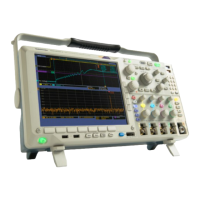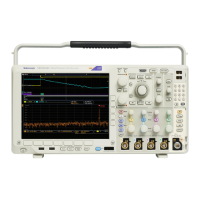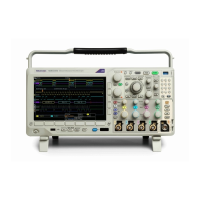Acquire the Sign
al
7. Turn multipurp
ose knob a to scroll through
the list of digital channels. Turn multipurpose
knob b to position the selected channel.
As you positio
n channels close to each other
on the display, the oscilloscope groups the
channels, and adds the group to the pop-up
list. You can
select the group from the list to
move all the channels in the group instead of
individual channels.
8. Push the low
er-bezel Thresholds button.
You can assign a different threshold value
to each channel.
9. Push the lo
wer-bezel Edit Labels button
and create the label. You can create labels
through the front panel or with an optional
USB keyboa
rd. (See page 51, Labeling
Channels and Buses.)
10. P ush the lower-bezel MagniVu button to
increase
the timing resolution. (See page 75,
When and Why to Turn On MagniVu.)
11. Push the lower-bezel Height button
repeate
dly to set the signal height. You only
need to do this once to s et the height for all
of the digital channels.
Quick Tip
Use the zoom feature to see multiple cycles of the signal in the upper part, and a single cycle in the lower part of the
display. (See page 144, Using Wave Inspector to Manage Long Record Length Waveforms.)
When setting up the logic probe, the first set of eight leads (pins 7 to 0) on the logic probe are marked GROUP 1 on the
lead box. The second set (pins 15 to 8) is marked GROUP 2.
Theleadforthefirst channel in each g roup is colored blue for easy identification while you connect the logic probe to the
device under test. The other leads are gray.
Digital channels store a high or low state for each sample. The threshold that separates high from low can be set
separately for each channel.
74 MDO4000 Series Oscilloscopes User Manual

